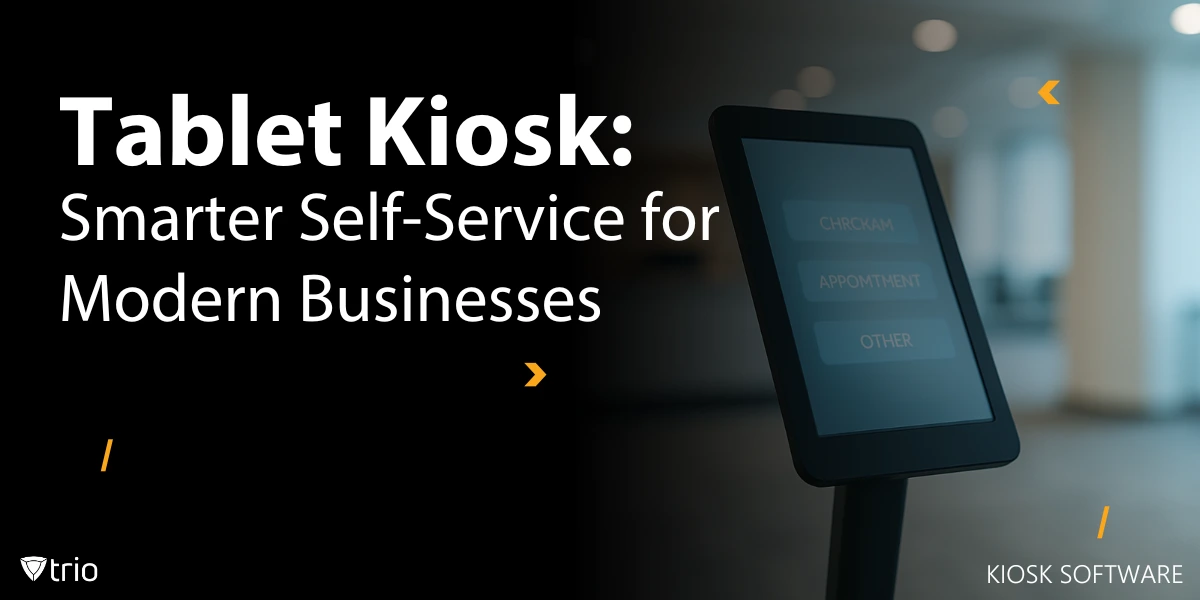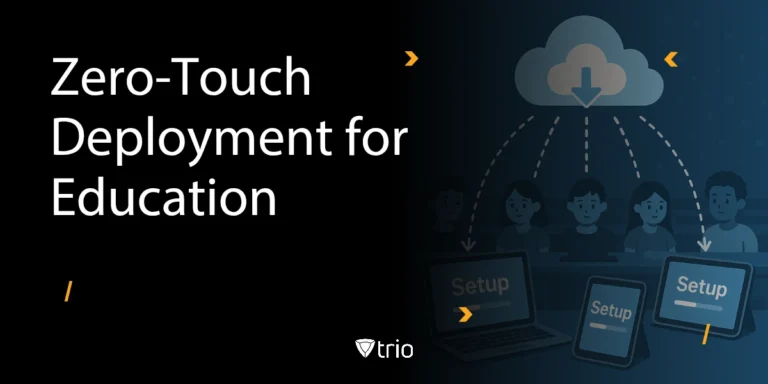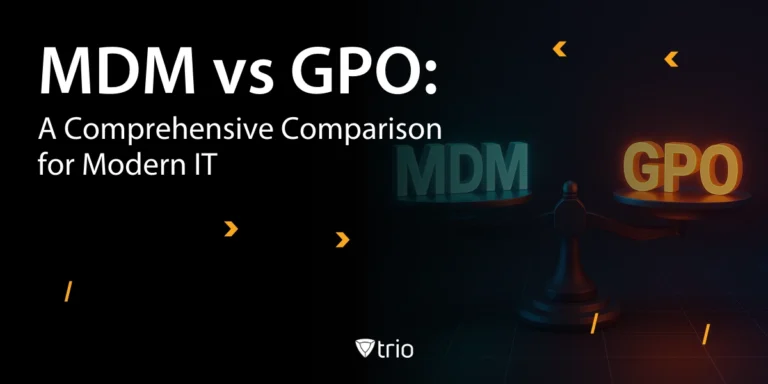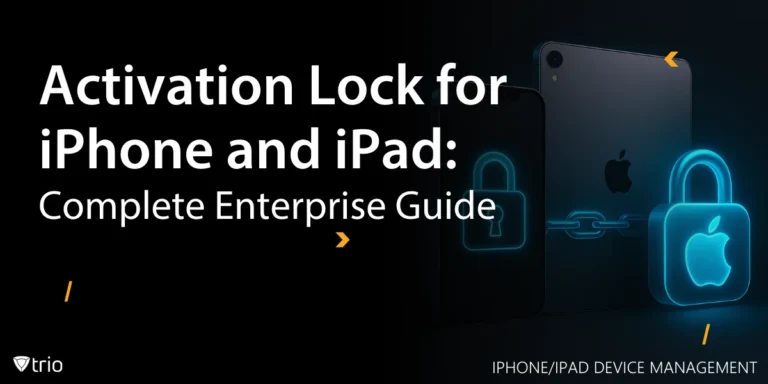According to Deliverect, seventy-three percent of shoppers now choose self-service checkout instead of waiting in line, and businesses that deploy kiosks often see ticket sizes climb by about 30 percent. Those numbers make a powerful case for the humble tablet kiosk, but they can also make an IT admin’s pulse quicken. Every new screen is another endpoint to maintain, patch, and secure.
That is where a solid Mobile Device Management (MDM) platform comes in. With remote provisioning, policy control, and live monitoring, MDM turns a potential headache into an operational win.
Quick takeaways
- Faster customer journeys that lift satisfaction and revenue
- One dashboard to push updates and lock down apps
- Built-in safeguards against tampering and data leaks
- Fewer support tickets thanks to self-healing policies
- A direct path to improved operational efficiency
In the sections that follow, we will unpack what a self-service tablet kiosk can do for your team, spotlight real-world failure stories, and show why clinging to legacy tools is riskier than you think.
What Is a Tablet Kiosk?
A tablet kiosk is a standard iOS, Android, or Windows slate that has been locked into a single mission, usually customer facing. Unlike bulky traditional kiosks, a self-service tablet unit runs on off-the-shelf hardware, so you save on capital costs and keep spare parts easy to source. Configuration is handled through kiosk mode settings or an MDM, which strips away the status bar, settings menu, and swipe gestures, allowing only the app—or apps—you authorize. That tight control keeps curious fingers out of trouble and dramatically cuts support tickets.
Tablet kiosks shine in stores, hotels, and hospitals where floor space is limited and staff are stretched thin. Paired with digital signage software, the same device can double as a promo screen when idle, giving you one platform for both transactions and marketing. In short, this is a lean, affordable front-end that still meets enterprise-grade security and uptime requirements.
Types of Tablet Kiosk Modes
Picking the right operating mode is where most SMB rollouts sink or swim. Below are the four settings you’ll reach for 90 percent of the time, all of which can be pushed remotely with your preferred tablet kiosk software solutions.
- Single App Mode: Locks the tablet to one APK or iOS bundle. Perfect for point-of-sale, surveys, or a loyalty sign-up screen. Customers see only what you want, and there is no chance they wander into Settings.
- Multi-App Whitelist: Need a second app for receipts or a loyalty scanner? Whitelist a short list of essentials while blocking the rest. A soft home button or gesture switcher takes users back to your launcher rather than the default shell.
- Browser-Only Web Kiosk: The tablet boots straight into a full-screen browser. Great for knowledge bases or queue check-ins where the interface lives in the cloud. Pair it with a strong content filter so no one Googles kittens on your shop floor.
- Custom Launcher Mode: Replace the stock launcher with a branded shell or kiosk lockdown software. It hides the status bar and hardware buttons, creating a polished, foolproof start screen.
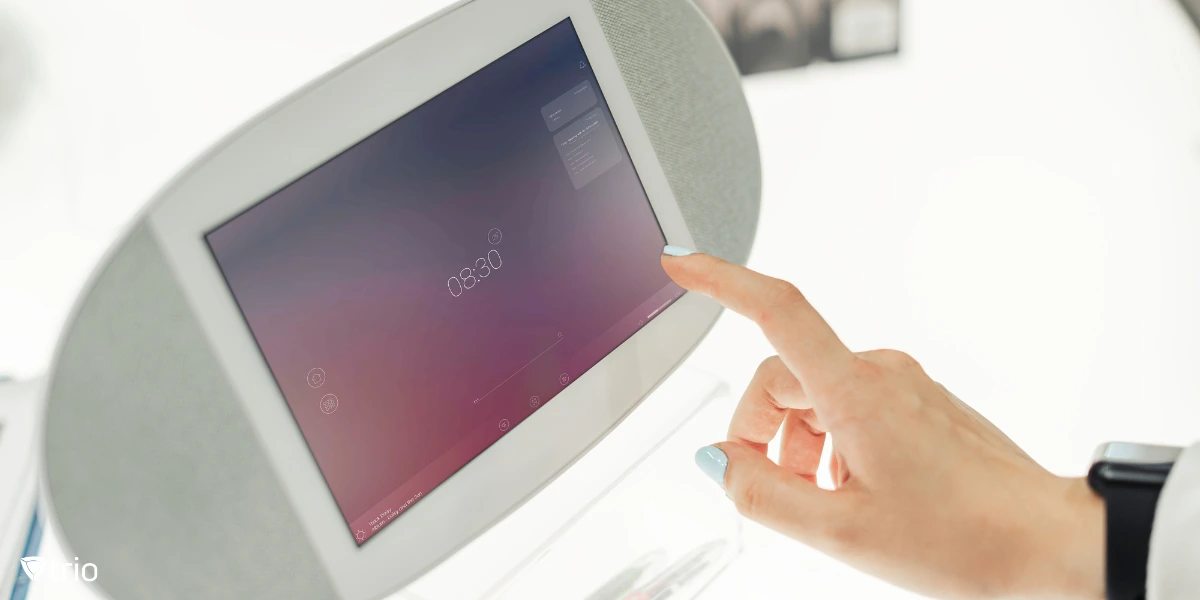
Common Use Cases
Tablet kiosks punch well above their weight in a wide range of small-business environments, especially when paired with an interactive kiosks software layer that snaps into your MDM console.
| Scenario | How the Kiosk Helps | Why IT Cheers |
| Retail & POS | Self-checkout, endless-aisle catalogs, loyalty sign-ups | Shorter lines, bigger basket sizes, fewer POS terminals to patch |
| Hospitality | Guest check-in, keyless room access, digital menus | Shaves minutes off arrivals, keeps front-desk devices locked and compliant |
| Healthcare | Patient intake forms, consent signatures, tele-triage | Reduces paperwork, protects PHI, supports sanitizable hardware |
| Education | Exam portals, campus mapping, library look-ups | Cuts printer costs, offers controlled internet access during tests |
| Transport & Events | Wayfinding, ticket scanning, lead capture | Handles surges without extra staff, syncs data instantly to the cloud |
Across all these settings, admins rely on tablet kiosk remote monitoring to watch battery health, network uptime, and app status in real time. That visibility means you can dispatch field staff only when a genuine issue pops, instead of performing costly weekly walk-arounds.
Setup & Deployment
Rolling out fifty locked-down tablets should not feel like a weekend of hand-flashing each device. Start by enrolling every unit into your MDM with zero-touch or QR-code provisioning. Within minutes they auto-download your kiosk profile, wallpaper, and Wi-Fi credentials, ready for action.
For Android fleets, lean on remote android kiosk management presets:
- Enable kiosk mode at boot. Guards against accidental factory resets.
- Whitelist updates. Push only approved OS and app patches during off-hours to avoid kiosk downtime.
- Schedule watchdog reboots. A nightly restart clears memory leaks before users notice.
Tie these tasks into your broader IT process automation playbook so firmware checks, content refreshes, and compliance audits run on autopilot. The same scripts that patch laptops can now sweep your kiosks, closing security gaps without extra headcount.
Finally, confirm power and network stability at each location. Cheap PoE adapters or locked charging cradles save you from dead-battery calls. Do a walk-through once, then let the dashboard do the watching.
Key Features & Customization
Fine-tuning each tablet kiosk is easy when you know which levers to pull. The features below, from a branded kiosk launcher to an auto-reboot kiosk device schedule, give SMB IT admins full control without adding headcount.
| Feature | What It Solves | Typical Use Case |
| Kiosk Launcher | Hides native home screen and system UI to stop tampering | Retail demo tablets that must stay on one branded start screen |
| Disable Hardware Buttons | Prevents accidental app exits or factory resets | Check-in kiosks at hotels where guests might press the power key |
| Hide Status Bar & Notifications | Keeps alerts and settings away from customers | Healthcare intake forms that display PHI and must stay distraction-free |
| Auto-Reboot Kiosk Device | Clears memory leaks, restores crashed apps | Busy food-court ordering stations that run 18 hours a day |
| Watchdog Timers | Auto-relaunches an app if it freezes | Museum info tablets used by children who often force-close apps |
| Branding & Screen Savers | Matches corporate identity, shows promos when idle | In-store product displays that double as digital signage at night |
Capture these settings once in your MDM console, then clone the profile fleet-wide. Every new tablet powers on with identical controls, branding, and self-healing routines, no manual tweaks required.
Remote Management
When your kiosks are scattered across stores, clinics, and pop-up stands, the only sustainable strategy is to manage them from one pane of glass. A solid MDM console lets you see every device’s battery state, Wi-Fi signal, and app health at a glance, then push fixes before users notice a hiccup. Think of it as mission control for your fleet.
| Live Metric | Why It Matters | Admin Action |
| Battery below 20% | Prevent abrupt shutdowns at peak hours | Send low-power alert and dim screen remotely |
| App not responding | Protect brand image and revenue | Force-restart process or trigger watchdog |
| Offline > 15 min | Spot network dead zones fast | Reboot modem or escalate to site staff |
| OS out of date | Close security gaps | Schedule overnight patch |
Layer in secure collaboration tools so only authorized staff can issue remote commands, and every change is logged for audits. Result: fewer truck rolls, tighter compliance, and happier customers tapping a kiosk that simply works.
Security & Privacy
Locking a tablet to one task is only half the battle; you still have to protect sensitive data from every angle. Start by deciding between device lockdown and browser lockdown: the former seals the entire OS, while the latter restricts users to a hardened web view for SaaS portals. Either way, enforce admin-only exit codes, disable USB debugging, and hide system UI so no one sideloads rogue apps.
Next, encrypt local storage and block screenshots to stop casual data leaks. Schedule remote wipes for lost units, and use geofencing rules that trigger read-only mode outside approved locations. For healthcare or retail payment flows, add Data Loss Prevention policies that flag clipboard use or unapproved downloads.
Finally, keep an audit trail. Every config push and app update should log to your MDM, giving you airtight evidence for PCI DSS or HIPAA checks. Combined with nightly OS patches, these controls turn an inexpensive slate into a compliance-ready, tamper-proof kiosk.

Hardware & Peripheral Integration
Getting the enclosure right is as important as the software profile. Choose wall mounts, freestanding podiums, or countertop cases that hide cables and protect ports from prying hands. Outdoor units need weather-sealed gaskets and daylight-readable glass, while healthcare kiosks benefit from antimicrobial coatings that survive daily wipe-downs.
| Peripheral | Why Pair It with a Tablet Kiosk | Real-World Example |
| Barcode or QR Scanner | Speeds check-ins and inventory pulls | Self-service returns desk scans receipt codes |
| Thermal Receipt Printer | Delivers immediate proof of purchase | Food-court kiosk prints order numbers for pickup |
| Chip-and-PIN Payment Terminal | Adds secure, PCI-ready transactions | Mobile pop-up shop takes contactless payments |
| RFID/NFC Reader | Enables badge or wristband authentication | Fitness center tracks member visits hands-free |
| External Display Output | Extends to larger screens for promos | Quick-service counter mirrors menu to TV using digital signage software |
Power each accessory through a powered USB hub or PoE splitter tucked inside the enclosure to avoid floor clutter. Test firmware compatibility before mass deployment so updates do not break critical drivers. Once locked down, the hardware blend becomes an invisible part of the customer journey, fast, reliable, and built to last.
Deployment Tips and Best Practices
Rolling out a fleet can bog down small IT teams, but tight planning keeps the project light:
- Pick a kiosk-centric MDM. Generic tools miss launcher settings, auto-reboot rules, and granular lockdown options.
- Stage before ship. Enroll every tablet, push the kiosk profile, and run a five-minute smoke test while devices are still in the office.
- Document the install kit. Include mount screws, cable ties, and a laminated quick-reset card so field techs are never hunting parts.
- Schedule health checks. Automate weekly reports for battery cycles, storage use, and crash logs; clear red flags before users see them.
- Lock in power hygiene. Use PoE or tamper-proof chargers, then cap screen brightness after hours to extend panel life.
- Plan a rollback path. Keep the previous APK and OS image in your MDM vault so a bad update can be reversed in minutes.
- Set a cleaning protocol. Alcohol-safe wipes twice daily and a monthly screen protector swap keep devices hygienic and customer ready.
Following these steps prevents fire-drill support calls and frees admins to focus on higher-value projects.
Get Started Today
Ready to see how effortless kiosk management can be? Spin up a free Trio trial today and experience full-fleet control without the enterprise price tag. In no time, you’ll enroll a test device, push a custom launcher, and schedule an auto reboot—all from one intuitive dashboard.
With your free Trio demo you can:
- Lock any tablet into single-app mode and verify settings live
- Automate OS and app updates on your schedule
- Track uptime, battery health, and usage analytics in real time
- Invite teammates with role-based access and a complete audit trail
Start a free trial or book a free demo now. No credit card, no commitment, just proof that SMB IT teams can run pro-grade kiosks without extra headcount. Questions? Our engineers are a chat away and happy to walk you through your first deployment.
Conclusion: Rethinking Kiosks for the Modern SMB
Tablet kiosks are a frontline tool for delivering fast, secure, and scalable customer experiences. But without proper management, even the slickest setup can spiral into support tickets, compliance risks, and missed opportunities.
For IT admins juggling limited budgets and growing device fleets, the key is automation and visibility. From remote monitoring to lockdown modes, the right strategy turns consumer-grade tablets into enterprise-ready workhorses.
Whether you're just exploring kiosk use cases or already knee-deep in a rollout, now’s the time to rethink how you deploy, secure, and scale. Done right, kiosks don’t add work: they take it away.
Frequently Asked Questions
Most consumer-grade iOS/Android/Windows tablets work! MDM locks down your existing devices, eliminating costly proprietary hardware.
With zero-touch enrollment, deploy 100+ devices in hours, not weeks. Bulk-provision via QR codes or automated enrollment.
MDM watchdog timers auto-restart apps, and scheduled reboots clear memory leaks—no on-site visits needed.
MDM disables hardware buttons, hides status bars/blocks swipes, and enforces admin-only exit codes.
Yes. MDM enforces encryption, blocks screenshots/clipboard, and triggers remote wipes if devices are stolen.
Audit trails, DLP policies, and automated OS patching provide documented compliance proof.
Yes! Push updates remotely during off-hours to avoid downtime. Roll back bad updates instantly.
MDM dashboards show real-time battery, network, and app health, with alerts for issues like low power or offline status.
MDM alerts you at 20% battery, letting you remotely dim screens or notify on-site staff.
Businesses report 60–80% fewer support tickets thanks to remote troubleshooting and self-healing policies.
Yes! Reduced lines + larger ticket sizes (via upsell prompts/endless-aisle catalogs) drive measurable revenue growth.
Absolutely. Use idle-time screen savers with digital signage to turn transactional kiosks into marketing tools.
Most USB/Bluetooth devices (barcode scanners, receipt printers, payment terminals) integrate seamlessly.
Yes! Start a no-commitment trial to remotely lock devices, push updates, and monitor performance.
Get Ahead of the Curve
Every organization today needs a solution to automate time-consuming tasks and strengthen security.
Without the right tools, manual processes drain resources and leave gaps in protection. Trio MDM is designed to solve this problem, automating key tasks, boosting security, and ensuring compliance with ease.
Don't let inefficiencies hold you back. Learn how Trio MDM can revolutionize your IT operations or request a free trial today!
